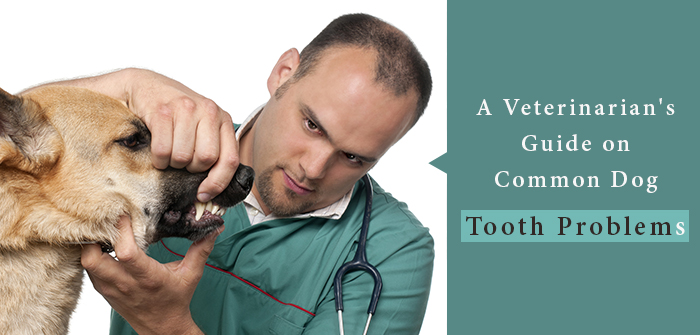A Veterinarian’s Guide on Common Dog Tooth Problems
It has been estimated by veterinary dentists in our country that approximately 85% of dogs more than 4 years of age are suffering from some kind of dental ailment. The two most common problems faced by our canine companions are: Periodontal disease and mismatch of the jaws and teeth. It is very difficult to examine tooth problems in doggies when you see their mouths. But with a little bit of learning it is possible to recognise common tooth issues that can save the pet from pain, tooth loss and infection.
Let us now look at some of the commonly found tooth problems in canines from a veterinarian’s perspective:
Loose Teeth
If a puppy starts loosing the teeth, it is not a big problem. Just like a human baby, puppies go through the process of loosening and falling out of teeth known as deciduous teeth, to make room for larger, permanent teeth. This process commences between 4 to 6 months of age and concludes around 8 months of age when the doggy has all the 42 adult teeth in place.
But if an adult doggy experiences loose teeth it can be a clear-cut indication of advanced periodontal disease. It can even be due to trauma to the mouth. Due to the presence of bacteria in periodontal disease, dogs may experience gum and bone degeneration that makes the tooth roots to detach from the fibres and periodontal ligaments holding them snugly in place. It can even be caused due to blow to the mouth or some sort of oral trauma. If you find that your canine is experiencing loose teeth, take him to the veterinarian immediately to determine the exact cause for this problem. The veterinarian may recommend an extraction.
Teeth Requiring Extraction
Teeth extractions are one of the most prevalent oral surgery performed on dogs. As a rule, the veterinarian tries to salvage as many teeth as possible. But teeth extraction may be compulsory when a tooth is injured and the root is no longer healthy and viable. This can happen when:
-
The tooth is loose and no longer attached to the bone
-
The teeth are misaligned and crowded
-
If a deciduous tooth is retained in the mouth amongst the permanent teeth
-
Teeth affected by odontoclastic resorptive lesions
It looks like a hole in the base of the tooth with a reddish dot.
Misaligned Teeth
Misalignment of teeth is often found in certain dog breeds that are renowned for their distinctive bite. It can cause the doggy difficulty in chewing or drinking normally. The misaligned teeth can sometimes rub against the soft tissues inside the dog’s mouth resulting in sores and pain. Veterinarians would opt to either extract or cap the crooked teeth to relieve the dog from the pain.
Broken Teeth
Fractured or broken teeth are commonly found in both dogs and cats. It can be caused due to trauma or chewing on hard objects. Due to the broken teeth, the tooth pulp and the root are exposed to the bacteria in the mouth resulting in infection. It can cause abscesses and bone demolition at the tip of the tooth root. If not treated on time, the infection can enter the pet’s bloodstream to other parts of the body like kidneys, heart and liver and can cause major harm to these vital organs. It has been observed that the fang teeth in canines and felines and the upper 4th premolar in dogs are the teeth that are mostly found worn or broken.
There are three options recommended by veterinarians to treat fractured teeth. Root canal therapy is the best treatment if the doggy is not affected by periodontal disease with intact roots. The second option is a vital pulpotomy where the pulp is removed, the area is sterilised and the pulp chamber is fixed. This option is recommended when the dog or cat is less than 18 months of age. The last option is tooth extraction which veterinarians prefer to avoid. It can also very difficult to perform since it is contingent on the size and nature of the broken teeth. It can also be very painful for the pet as he/she can lose the chewing function of that tooth.


